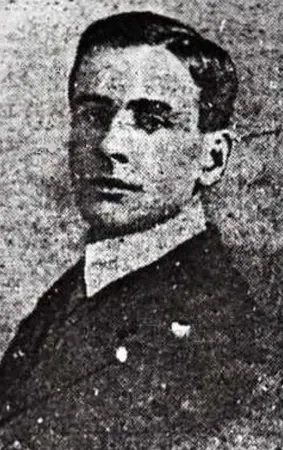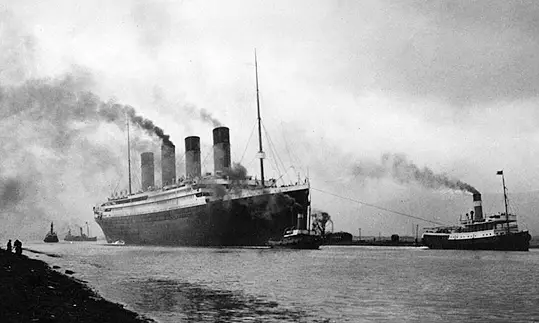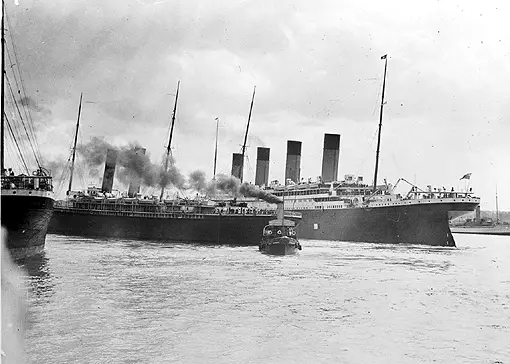Side Menu:
Fourth Officer Joseph Boxhall
-R.M.S Titanic

Joseph Boxhall in 1912.
At 9 a.m. on the 26th of March 1912 Boxhall and the other junior officers of the Titanic - Third Officer Herbert Pitman, Fifth Officer Harold Lowe and Sixth Officer James Moody - collected tickets from the White Star Line marine superintendent in Liverpool for their journey to Belfast. They departed from Liverpool at around 10 pm that night and were aboard the new ship by noon the following day.
In Belfast, Boxhall was aboard during Titanic's sea trials that took place on April 2nd and described that he was on the bridge deck and that "there were the builder's men on board, and I was just there to keep lookout and do anything I was told to do." (US Inquiry (25.)) He was also specifically involved in the testing of the port side lifeboats. Fifth officer Lowe described this at the US Inquiry:
Mr. LOWE. Mr. Moody and myself and Mr. Pitman and Mr. Boxhall took the port boat - that is, I took the starboard, and they took the port, and we overhauled them; that is to say, we counted the oars, the rowlocks, or the thole pins, whichever you like to call them, and saw there was a mast and sail, rigging, gear, and everything else that fitted in the boats, and plugs, and also that the biscuit tank was all right, and that there were two breakers in the boat, two bailers, two plugs, and the steering rowlock; that is, the rowlock for the oar that you ship aft when there is a heavy sea running, because you can not steer by rudder when there is a heavy sea running, and you put an oar over and you have greater command over an oar and can put more power on it. (US Inquiry (25.))
Boxhall confirmed the contents of the lifeboats during the US Inquiry: "Boat hooks, water, water breakers, bread tanks, dippers for the water breakers, balers for the boats, mast and sail, compass… lights and a can of oil. A lamp and a can of oil… All the gear was in the boats when we left Belfast; I know that. All the gear was in the boats, because I went around…Everything that the Board of Trade requires was in the boats in Belfast.…The provisions were, I know, because the provisions are built in with the boat. They are in a tank that is built in the boat. " (US Inquiry (25.))
Boxhall also recalls that each lifeboat had two extra oars that were stored on top of the seats: "I really forget how many oars there were, but there are always two extra ones; there are always two extra oars in the boat." (US Inquiry (25.)).

Titanic guided along the Victoria Channel and out towards Belfast Lough for the start of her sea trials, 2nd April 1912. According to Boxhall during the trials he was on the bridge deck and "there were the builder's men on board, and I was just there to keep lookout and do anything I was told to do."
He also noted the four collapsible boats for which he gave a description: "The lower part of the boat is wood, and these boats when they are loaded do not seem to me to have very much freeboard except for the canvas which, is pulled up before these boats are lowered... it is rather a shallow boat with a canvas to it which pulls up and forms a kind of protection around the people sitting in the boat."
And he was of the opinion that ever used they would be filled from the deck saying "We always lower the boat to the level of the rail or the level of the deck, so the people can step in." (US Inquiry (25.))
Finally, once the sea trials were complete they left Belfast for Southampton: "We left Belfast about noon… on a Tuesday. And we steamed until about between 7 and 8 o'clock at night. We finally left Belfast about 8 o'clock at night." (US Inquiry (25.))
Southampton
Nearing Southampton in the new Titanic, Boxhall noted a change in the weather. "The weather was fine until about 2 o'clock in the morning.… When I came on duty at 4 o'clock in the morning it was foggy… it cleared up about 6 o'clock in the morning." (US Inquiry (25.))
Once they arrived in Southampton there was opportunity when not on watch to visit the city. "I went around the town. I went ashore….When my watch was over… The last time I was ashore I returned the night previous to sailing, about 11 o'clock, I suppose." (US Inquiry (25.))
On the day of sailing "the lifeboats were lowered in the presence of the Board of Trade surveyors... within an hour or a couple of hours of the ship's sailing." Boxhall was not personally present at this test but instead it was overseen by "the captain, all the officers, the marine superintendent, and the Board of Trade surveyors, and the Board of Trade doctor." He reports that he "saw them in the water, but I was not actually on the spot when they were lowered… First the boat had to be cleared. After the boats are cleared the chocks are knocked down, or dropped down by patent levers, and the boat is hanging free. Then the davits are screwed out and the boat is suspended over the ship's side all ready for lowering away." They were lowered "far enough to clear the ship's side, right away down, and allow the boat to touch the water." (US Inquiry (25.))
As there had been a coal strike, there was also an issue with obtaining enough coal for the departure. Boxhall "said there had never been any idea of a record-breaking run; extra coal would have been needed for that. As it was, to get away on the sailing date, they'd had to rob the bunkers of other ships of the company in port owing to the 1912 coal strike. "("A Talk by the Fourth Officer of the Titanic", May 1959, Nautical Magazine, pages 262 - 264)

S.S. New York moves away from the dockside berthed R.M.S. Oceanic (left) and swings dangerously close towards Titanic (right). Boxhall was later reported to say: "She was hoodoo'd from the beginning..." (Click image to enlarge)
As for Boxhall and his fellow officers, there is an interesting exchange during the US Senate Inquiry in which Boxhall was asked about the "habits" of his colleagues and confirmed that he knew "only what I have seen since I joined the ship. I had never seen them before, except Mr. Lightoller... Good, steady, reliable men." When Senator Smith asked about Boxhall's own habits he replied: "You had better ask someone else." Single, 28 year old Boxhall had testified that he went ashore alone the night of April 9th – the day before Titanic sailed from Southampton – and returned to the ship at about 11 o’clock. (United States Senate Inquiry)
Departure
As Titanic departed at noon on Wednesday April 10th from Southampton, the Fourth Officer's position was on the bridge alongside the commander, Captain Smith, while being in charge of the telegraphs as they left port, according to the White Star Line's "General Regulations." Not long after departure those telegraphs were ringing more than usual as Titanic was involved in an incident with the SS New York which due to suction as Titanic passed by broke her moorings, snapping with 'reports like a revolver firing.' They would have collided if it wasn't for Titanic immediately stopping her engines and tugs guiding the New York to safety. However, Boxhall, like many superstitious sailors, saw something ominious in this incident. After Titanic sank, once aboard Carpathia he was reported to have said to Captain Rostron: "She was hoodoo'd from the beginning... " ("Tramps and Ladies" by Sir James Bisset, P.R.Stephensen, 1959)
As Titanic continued on her way, Fourth officer Boxhall's duties while at sea began. He described his role as a junior officer in the following: "To generally assist the senior officer of the watch in all cases... When the Titanic left Belfast Lough. His duty is assigned to a man when he is assigned to his ship, and he grows up with it. He learns the different duties he has to perform in whatever rank he is on board ship. " (US Inquiry (25.))
As a junior officer he shared his watches with Sixth officer Moody. This included "dog watches" a shift in a maritime watch system that is half the length of a standard watch period which is formed by splitting a single four-hour watch period between 16:00 and 20:00 (4 pm and 8 pm) to form two two-hour dog watches, with the "first" dog watch from 16:00 to 18:00 (4 pm to 6 pm) and the "second" or "last" dog watch from 18:00 to 20:00 (6 pm to 8 pm). The logic behind this is to rotate the watches by creating an odd number of watches in a ship's day and hence avoid the same men being assigned the mid-watch (midnight to 4 am) every night.
Aboard Titanic in practice this meant:
|
Regular Sea Watches |
|
|
First watch |
8pm - Midnight |
|
Middle watch |
Midnight - 4am |
|
Morning watch |
4am - 8am |
|
Forenoon watch |
8am - Noon |
|
Afternoon watch |
Noon - 4pm |
|
First Dog Watch |
4pm - 6pm |
|
Second Dog Watch |
6pm - 8pm |
|
Senior Officer of the Watch |
||
|
Chief Officer Henry Wilde |
2am - 6am |
2pm - 6pm |
|
2nd officer Charles Lightoller |
6am - 10am |
6pm - 10pm |
|
1st officer William Murdoch |
10am - 2pm |
10pm - 2am |
Because of the "Dog Watches", the Junior Officer's watches rotated every two days:
|
Junior Officers - Day 1 |
|
|
4th Officer Boxhall & 6th Officer Moody |
12am - 4am |
|
3rd Officer Pitman & 5th Officer Lowe |
4am - 8am |
|
4th Officer Boxhall & 6th Officer Moody |
8am - 12pm |
|
3rd Officer Pitman & 5th Officer Lowe |
12pm - 4pm |
|
4th Officer Boxhall & 6th Officer Moody |
4pm - 6pm (First Dog Watch) |
|
3rd Officer Pitman & 5th Officer Lowe |
6pm - 8pm (Second Dog Watch) |
|
4th Officer Boxhall & 6th Officer Moody |
8pm - 12am |
|
Junior Officers - Day 2 |
|
|
3rd Officer Pitman & 5th Officer Lowe |
12am - 4am |
|
4th Officer Boxhall & 6th Officer Moody |
4am - 8am |
|
3rd Officer Pitman & 5th Officer Lowe |
8am - 12pm |
|
4th Officer Boxhall & 6th Officer Moody |
12pm - 4pm |
|
3rd Officer Pitman & 5th Officer Lowe |
4pm - 6pm (First Dog Watch) |
|
4th Officer Boxhall & 6th Officer Moody |
6pm - 8pm (Second Dog Watch) |
|
3rd Officer Pitman & 5th Officer Lowe |
8pm - 12am |
See also...
Next... Chartroom